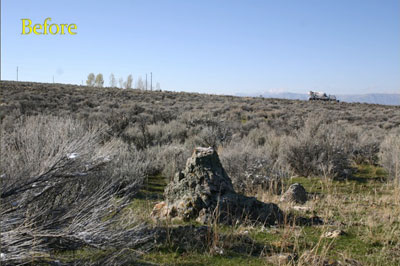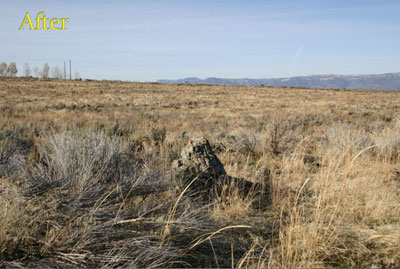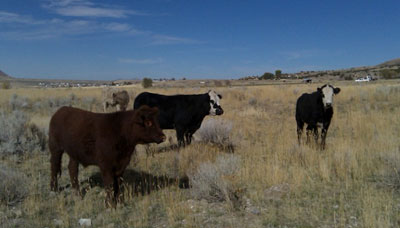Range Restoration
Converting Sagebrush Dominated Rangeland into Forage
Matt Palmer, USU Extension, Sanpete County
 Why Spend Time and Money to Reduce Sagebrush and Weeds?
Why Spend Time and Money to Reduce Sagebrush and Weeds?
- Increase forage quality and quantity
- Sagebrush pastures yield 50-200 lb of feed/acre
- Perennial grasses and forbs can yield 400 to 1000 lb of feed/acre
- Less expensive than buying land
- Land costs from $500 to $5000/acre
- Converting sage into forage costs about $150-$250/acre
- With GIP and DWR cost share it is under $100/acre
Benefits of Restoration: Increased Forage
- 40 acres producing 100 lb/acre with 60% utilization will feed 2.2 cows for a month
- 40 acres producing 900 lb/acre with 60% utilization will feed 20 cows for a month
 Keys to Success
Keys to Success
- Weed Management: Control of Cheat Grass, Bulbous Blue Grass, Knapweed, White Top, Thistle
- Forage Establishment: 1) Seed selection; 2) Seed bed prep; 3) Timing or planting and 4) Good spring and summer moisture
- Rest Period: No grazing for a year or more after planting;
- Management: Short grazing periods with adequate rest periods
JDP Ranch Pasture Restoration: A Case Study
Goals:
- Convert 229 acres of low producing sagebrush, cheatgrass and bulbous bluegrass pasture into a sustainable rotationally grazing pasture, with perennial grasses and legumes that will produce 500-1000 lb dry matter/acre.
- Complete this project with little or no out of pocket expenses.
 Steps for Restoration
Steps for Restoration
- Develop a plan and budget
- Site evaluation: 1) sagebrush and understory cover; 2) assess weed populations
- Fencing and water developments
- Sprayed sagebrush and weeds with 2-4,D and Roundup
- 2 way chain harrowt o prepare seedbed
- Drill seed (crested wheat, intermediate wheat, sainfoin, alfalfa, forage kochia)
- Install waterline and 5 troughs
- Cross fenced into 40 acre pastures
Overview
- Project was started July 2010 and completed June 2011
- Pastures rested until May 2012
- First year of grazing provided 60 AU for 2.5 months = 150 AUM
- The equivalent of 590 lbs of feed/acre on a dry year, enough feed for 200 ewes for a month on 40 acres
- Out of pocket expenses totaled less than $50/acre
Budget
| Practice | Cost/unit | Quantity | Units | Total cost | GIP cost | Producer cost |
|---|---|---|---|---|---|---|
| Fence | 1.3 | 8970 | ft | 11661.00 | 5830.50 | 5830.50 |
| Pipeline | 2.06 | 5783 | ft | 11912.98 | 5956.49 | 5956.49 |
| Troughs | 1 | 6000 | gal | 6000.00 | 3000.00 | 3000.00 |
| Chemical Roundup | 13.85 | 229 | ac | 3171.65 | 1585.83 | 1585.83 |
| Chemical application | 8 | 229 | ac | 1832.00 | 916.00 | 916.00 |
| Chemical 2, 4-D | 7.6 | 229 | ac | 1740.40 | 870.20 | 870.20 |
| Chemical application | 8 | 229 | ac | 1832.00 | 916.00 | 916.00 |
| Chain Harrow | 39.2 | 172 | ac | 6742.40 | 3371.20 | 3371.20 |
| Range Seeding drill | 20 | 229 | ac | 4580.00 | 2290.00 | 2290.00 |
| Seed | 30 | 229 | ac | 6870.00 | 3435.00 | 3435.00 |
| Broadcast seed | 10 | 229 | ac | 2290.00 | 1145.00 | 1145.00 |
| Total | $58,632.43 | $29,316.22 | 29,316.22 |

Conclusion:
Increased forage production from 100 lbs/acre to over 900 lbs/acre for $50/acre plus tractor hours and labor. And Happy Cows
Project Team
- Tom Tippets (UDAF, GIP)
- Kendall Bagley (NRCS/DWR)
- Soren Nielsen (NRCS)
- Jason Vernon (DWR)
- Chad Dewey (Eco-life)
- JDP Ranch Family

